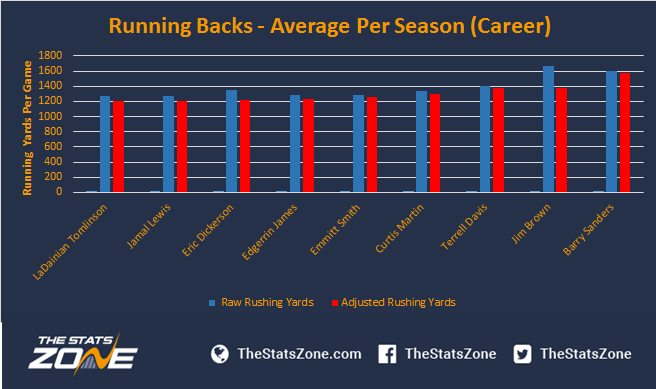This article continues our comparison of modern-day NFL players with their predecessors. Previously, we took a look at quarterbacks and the rise in passing, whereas today, we turn to a position that hasn't received the recent love that quarterbacks have enjoyed – the running back. Passing is on the rise and rushing is on the decline; 2016 marked the first season since 1999 that teams averaged under 110 rushing yards per game. Let's take a look at the statistics for the past 50 years.

While the present-day amounts aren't quite at the historic lows of the 90s, they're getting pretty close. Also of note is the immense popularity of rushing during the 70s, when stars such as Walter Payton and Earl Campbell (and yes, O.J. Simpson) carried the football. As in previous articles, we'll take a look at three different time frames for each running back: their best three-year streak, their best overall five years, and their career average. Note that we adjust for games played, both to compensate for the shorter seasons before 1978 and also to adjust for a player missing a single game or two due to injury within the season. We'll begin with the best streaks.

Terrell Davis come out on top here, posting an amazing 1,756 adjusted yards-per-game during the span of 1996-98. During the latter two seasons in this incredible run he also won two Super Bowl rings. Emmitt Smith and Barry Sanders round out our top three. In contrast to our quarterback examination, only one current player makes the cut – Adrian Peterson. We see that many older running backs such as Jim Brown and Eric Dickerson actually have their value lowered significantly, a side effect of playing in seasons that averaged over 10 more rushing yards a game than today. Moving on, we take a look at the strongest overall five years for running backs.

Sanders and Smith remain in the top three while Davis falls, being replaced by Eric Dickerson. Adrian Peterson also shoots up the list to fourth, and it wouldn't be a surprise to see him claim a couple more spots before his career is over. Possibly the most striking feature of this graph is the gap that Sanders has over second-place. He averaged 77 yards more, compared to the mere gap of 52 that Terrell Davis held over Smith (who again was in second-place). It remains the case that Adrian Peterson is our only current player on the list. As a side note, this is quite possibly due to the decline of bell-cow running backs in the NFL today. Many teams go with some form of running back by committee, or even just give their rushers more breaks than they used to. This trend doesn't diminish the talent of modern-day running backs, but certainly prevents them from accruing the stats of many of their predecessors. Moving on, we come to averages over their entire career.

We edited out all currently active players, as often a player's decline will adversely affect these numbers. Once again, we see Barry Sanders topping the list. This makes sense as not only is he clearly one of the most prolific rushers of all time (as evidenced by the previous graph), but he retired healthy and near the top of his game. Once again, Jim Brown is denied the top spot due to the era he played in, although it should be noted that his per-game average does benefit from shorter seasons. Emmitt Smith falls out of the top three for the first time, largely due to the last three years of his career, including a forgettable stint in Arizona.
So let's wrap it up. Two players from the 90s are prominent on all these lists – Barry Sanders and Emmitt Smith. Jim Brown and Eric Dickerson appear in the top three for career averages and top five years respectively, but both are hampered by having played in such rushing intensive eras. Terrell Davis also makes waves with his simply incredible streak (again, during the 90s) which included two Offensive Player of the Year awards, an MVP, and a pair of Super Bowls. Not bad for a sixth round pick.
